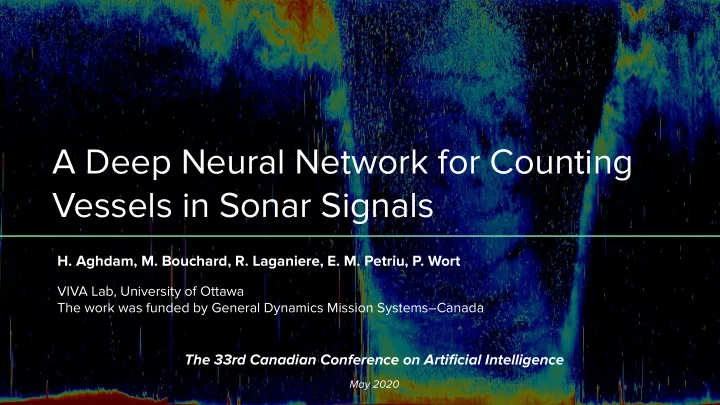

A Deep Neural Network for Counting Vessels in Sonar Signals H. Aghdam, M. Bouchard, R. Laganiere, E. M. Petriu, P. Wort VIVA Lab, University of Ottawa The work was funded by General Dynamics Mission Systems–Canada The 33rd Canadian Conference on Artificial Intelligence May 2020
Motivation Monitor sea borders and restricted areas ● Smuggles ○ Unauthorized access ○ Human operator ● Needs several operators to monitors a specific 24/7 ○ Training human operators can be costly and time consuming ○ Unusual activities are rare ○ We aim to automate this process using artificial intelligence 2
Sonar Signals Sonar is used in underwater applications ● Active sonar ● Emits a signal and listens to the signal that is reflected after hitting an object or the ocean floor ○ Passive Sonar ● Listens to ambient noise and the signal generated by marine objects ○ Active sonar is not suitable detecting the presence of vessels or counting them in restricted areas since vessels can acquire the signal that is sent by the active sonar. 3
How to Automate? Raw Sonar Spectrogram 1 Deep Neural Network 2 3 Absence of vessels (ie zero vessels) can be detected by computing second order statistics of the spectrograms 4
Idea 1st patch Extract Features Time Frequency 5
Idea (cont.) Extract Features 10 th patch Extract Features Time Frequency 6
Idea (cont.) Extract Features Extract Features Time …….. k th patch Extract Features Frequency 7
Idea (cont.) Extract Features Extract Features Time Integrate …….. k th patch Extract Features Frequency 8
Idea (cont.) Extract Features Extract Features Time Integrate Predict …….. k th patch Extract Features Frequency 9
Idea (cont.) Extract Features Extract Features Time Integrate Predict …….. k th patch Extract Features Frequency The goal is to perform this process end-to-end 10
Idea (cont.) Extract Features Extract Features Time Integrate Predict …….. k th patch Extract Features Frequency Given an input of TxF, we must design a network whose receptive field in the last feature extraction layer is 𝛽 TxF where 𝛽 < 1 11
Proposed Neural Networks 12
Proposed Neural Networks 𝛽 TxF receptive field Frequency Time 13
Experiments Synthesized a dataset ● 84K training samples ○ 6K validation samples ○ 27K test samples ○ Each sonar sample is synthesized using the following parameters: ● Heading ○ Bearing ○ Speed ○ Noise strength ○ Number of vessels ○ Range ○ Frequencies ○ Power ○ 14
Results 15
Results 2 targets 3 targets 1 target 16
Comparison 17
Conclusion Proposed a network to count the number of vessels in sonar signals ● Synthesizes a large dataset of passive sonar signals ● The results show a superior performance compared to traditional approaches ● Aim to use many-to-many predictions instead of many-to-one approach in this ● paper Improve our simulators and generate more challenging signals ● 18
Thank You https://gitlab.com/haghdam/deep_vessel_counting 19
Recommend
More recommend